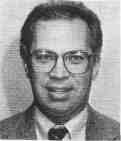
By WILLIAM T. SUNLEY, Engineer of Local Roads and Streets

|
A SURE FOUNDATION
By WILLIAM T. SUNLEY, Engineer of Local Roads and Streets |
Erosion of streambeds under bridge foundations (or, "scour") is the single most common cause of bridge failures. This point has been forcefully thrust upon us in recent years by two tragic bridge collapses. In 1987, scour brought down a pier that supported a bridge carrying the New York State Thruway over Schoharie Creek resulting in 9 deaths. Then, on U.S. Route 51 in Tennessee, two bridge spans fell into the Hatchie River in the Spring of 1989, taking 8 lives. With this backdrop, the Federal Highway Administration has put an emphasis on identification of bridges susceptible to failure due to streambed scour. As a result, the Illinois Department of Transportation along with state highway agencies nationwide has embarked on a program to determine which existing bridges are "scour critical" and to insure that all new bridges are designed for estimated scour.
Guidelines. The guidelines for the scour evaluation process have been spelled out in detail in Bureau of Local Roads and Streets Circular Letters 91-8 and 92-11. These guidelines incorporate the principles and methods in FHWA Hydraulic Engineering Circular #18 (HEC 18), Evaluating Scour at Bridges. They address screening (prioritization) and final evaluation of bridges for scour, respectively. About 16,250 structures on local agency roads and streets over waterways are the subject of this process. A monumental task lies before us.
Scour Screening. The first step in the scour evaluation process was to prioritize bridges for final evaluation. Scour screening has been completed for all but about 1% of local agency bridges. This screening was a simple step-by-step process which considered importance factors such as traffic volume, foundation type, existing scour problems and stream size. The screening groups are as follows:
— Group 1: High Priority — Bridges which have a high potential for problems caused by scour.
— Group 2: Low Priority — Bridges with a low potential for having significant scour problems.
— Group 3: Stable for Scour — Negligible or no possibility of problems caused by scour.
Scour Evaluation and Design. The final phase of the process is calculation of scour depths, evaluation of the results and determination of follow-up measures. Evaluation of existing structures for streambed scour requires individuals with knowledge in bridge hydraulic, foundation and structure design. Group 1 structures must be evaluated no later than June 30, 1995 depending on how many are under the jurisdiction of the affected agency. Final evaluation of Group 2 bridges is targeted for January 1, 1997. Group 3 bridges required no further scour evaluation.
If a bridge is determined to be scour critical, follow-up procedures must be instituted, which may include frequent monitoring during floods and/or installation of scour counter-measures. For example, large stones may be dumped around a pier or abutment that is calculated to have deep scour.
In addition to evaluation of the existing bridges, specific scour design is now required for each bridge replacement or rehabilitation project. While scour has been a consideration in bridge design in the past, there had never been a widely used quantitative analysis method until the publication of HEC 18. Typical considerations are the speed and volume of the stream flow, the size of the opening through the bridge and the type of material in the streambed. The methods introduced in HEC 18, while not the last word, provide a good basis for bridge design decisions regarding scour.
With the application of these scour evaluation measures, the safety for the users of our roadways and the integrity of our roadway system itself should be greatly enhanced. •
December 1992 / Illinois Municipal Review / Page 23
|
|